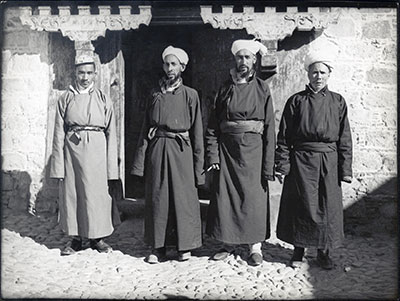
1998.131.284 (Print black & white)


1998.131.284 (Print black & white)

Frederick Spencer Chapman
Frederick Spencer Chapman
October 28th - November 4th 1936
Gulam Maidin Mohammed? , Asatulla Mohammed?
Lhasa > Dekyi Lingka
1998.131.284
127 x 170 mm
Print gelatin silver
Donated 1994
Faith Spencer Chapman
British Diplomatic Mission to Lhasa 1936-37
Frederick Spencer Chapman
C.12.1 [view film roll]
SC.T.2.284
BMR.86.1.40.1
Notes on print/mount - 'C/12/1' has been written on the back of the print in pencil across the centre. There is also a very small number '2' in the top right hand corner [MS 21/2/2005]
Manual Catalogues - Caption in Chapman's hand-written list of negatives made whilst on the Mission to Lhasa, 1936-7 [See PRM Manuscripts Collection]: 'The four Ladakis'; PRM Manuscripts Collection: ‘List of Tibetan Prints and Negatives’ - Book 2: ‘ “Rogues Gallery” - 38/5 - Representatives of the Ladakh Mohammedans in Lhasa. There are two or three hundred of them in Lhasa’ [MS 17/03/2006]
Research publication - Clare Harris and Tsering Shakya (eds.) 'Seeing Lhasa: British Depictions of the Tibetan Capital 1936-1947', Chicago: Serindia Publications, 2003, p.96
Exhibition - This image appeared in the 2003 Temporary Exhibition at the Pitt Rivers "Seeing Lhasa: British Depictions of the Tibetan Capital 1936-1947"
Other Information - Related Images: Images prefixed with 'C.12' comprise a group of negatives containing images of Ladakhi men, Ngagchen Rimpoche, Mir/Amir Khan (the mission cook), football match, Dagg, Kham dancers, Nechung, Drepung, Potala and sand track approaching it. All seem to have been taken between c. October 28th - November 15th 1936 [MS 17/03/2006]
Other Information - Dates: This image was taken before the fist football match between the Mission and the Ladakhi community, which took place on November 10th 1936. However, in the mission diary for that date, Richardson wrote that a few days prior to this the challenge had been made to take part in the match. This suggests that the image was taken a few days before November 10th and may relate to the invitation being made as the image seems to have been taken outside the Dekyi Lingka [MS 17/03/2006]
Other Information - Historical Background: Four representatives of the Ladakhi Muslim community in Lhasa. In the 1930s there were around two to three hundred Muslims in Lhasa. When the 5th Dalai Lama took Ladakh into his sphere of influence in the 17th century, a small community of Muslims established themselves in Lhasa as traders and butchers. They were known as “Khache” (Tibetan for Kashmiri) and had their own mosque in the south-eastern corner of the city. [CH 2003]
Other Information - Historical Background: Chapman describes the situation of the Ladakhi community in Lhasa in his book Lhasa the Holy City [London: Chatto & Windus; reprint, London: Readers Union Ltd., 1940]. He wrote: "Gulam Maidin Mahommad and Asatulla Mahommad, who had ridden out a day's journey to meet us on our arrival [visited August 31st 1936, Mission Diary], came soon afterwards to pay their respects to the Political Officer. These men, together with their two or three hundred compatriots in Lhasa, are Mohammedans from Ladakh, the north eastern province of Kashmir. Some of them are descendants of the Dogra force that unsuccessfully attacked western Tibet a hundred years ago. They are practically all traders and live in the south-eastern corner of the city, where they have a small mosque. They wear Tibetan dress, with the addition of a turban, and are clever and successful merchants. They approached the Political Officer to ask for extra-territorial rights similar to those enjoyed by the Nepalese, on the grounds that they come from Ladakh, which is part of British India; but as they have all the advantages and amenities of Lhasa and are not in any way oppressed, the request seemed unreasonable" [1940, p.96] [MS 2/4/2005]
For Citation use:
The Tibet Album.
"Ladakhi Moslems in Lhasa"
05 Dec. 2006. The Pitt Rivers Museum.
<http://tibet.prm.ox.ac.uk/photo_1998.131.284.html>.
For more information about photographic usage or to order prints, please visit the The Pitt Rivers Museum.
© The Pitt Rivers Museum